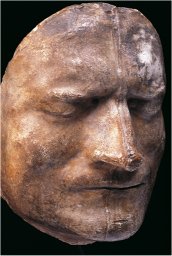|
 Kings College Cambridge
Kings College Cambridge
John Michael Rysbrack (1694-1770) was probably the artist who prepared this plaster death mask of Newton. Rysbrack was also the sculptor of the monument to Newton in Westminster Abbey (see catalogue number 67). Several copies of Newton's death mask were circulating among artists in the eighteenth century and a number survive. This one was bought by John Maynard Keynes at the Sotheby sale of Newton's manuscripts in 1936.
Newton died, covered with honours, in 1727 and was buried grandly in Westminster Abbey. He had become President of the Royal Society in 1703 and was knighted in 1705. As Master of the Mint from 1699, he was a wealthy and successful servant of the state.
Yet, as Newton's heirs investigated the books and manuscripts that remained after his death, it became increasingly apparent that the outward face of genius was quite different from the private life of an alchemist and heretic who had, for much of his life, deliberately avoided publicity of any kind.
Newton's books were sold and few of his papers were deemed worthy of publication. His heirs and their descendants guarded the rest of them closely. The transfer of the Portsmouth papers to Cambridge University in 1872 opened up the possibility of studying Newton's scientific development, as it was then conceived. In 1936, the 'personal' papers that had been returned to the family were sold at auction in order to meet death duties and other family expenses.
The economist, John Maynard Keynes, bought many of them and subsequently formed the view that Newton was 'the last of the magicians'. The study of the traces that Newton had left in the pages of his manuscripts began in earnest after 1945. It continues today around the world. With the University Library's acquisition of the Macclesfield Collection, letters and papers that were preserved by friends and disciples of Newton have been reunited for the first time since their creation with others that were kept by his family.

back to the top
|

